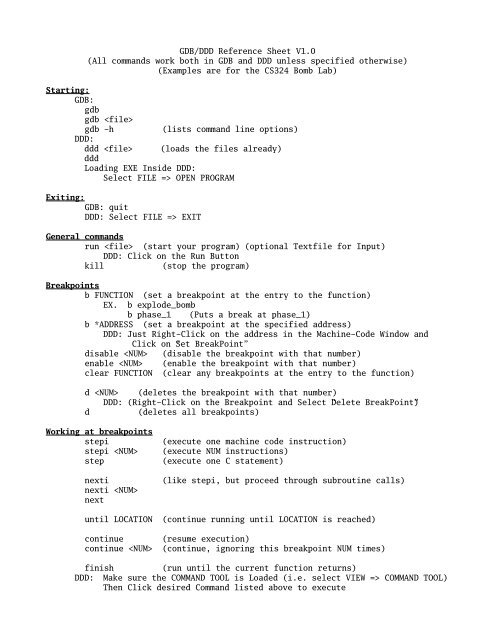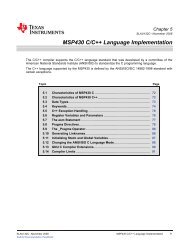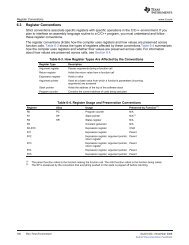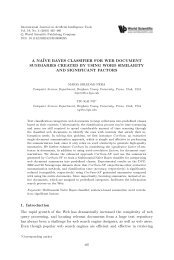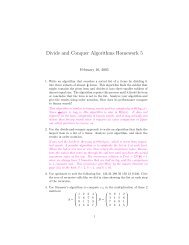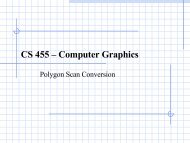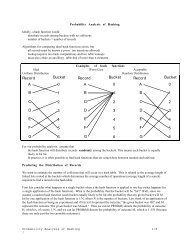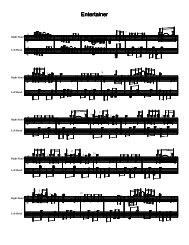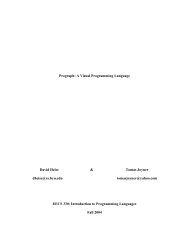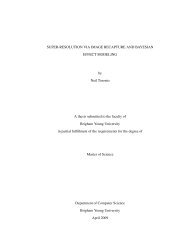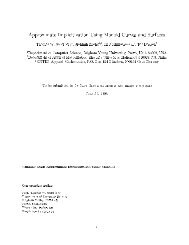GDB/DDD Reference Sheet V1.0 (All commands work both in GDB ...
GDB/DDD Reference Sheet V1.0 (All commands work both in GDB ...
GDB/DDD Reference Sheet V1.0 (All commands work both in GDB ...
Create successful ePaper yourself
Turn your PDF publications into a flip-book with our unique Google optimized e-Paper software.
<strong>GDB</strong>/<strong>DDD</strong> <strong>Reference</strong> <strong>Sheet</strong> <strong>V1.0</strong>(<strong>All</strong> <strong>commands</strong> <strong>work</strong> <strong>both</strong> <strong>in</strong> <strong>GDB</strong> and <strong>DDD</strong> unless specified otherwise)(Examples are for the CS324 Bomb Lab)Start<strong>in</strong>g:<strong>GDB</strong>:gdbgdb gdb -h(lists command l<strong>in</strong>e options)<strong>DDD</strong>:ddd (loads the files already)dddLoad<strong>in</strong>g EXE Inside <strong>DDD</strong>:Select FILE => OPEN PROGRAMExit<strong>in</strong>g:<strong>GDB</strong>: quit<strong>DDD</strong>: Select FILE => EXITGeneral <strong>commands</strong>run (start your program) (optional Textfile for Input)<strong>DDD</strong>: Click on the Run Buttonkill(stop the program)Breakpo<strong>in</strong>tsb FUNCTION (set a breakpo<strong>in</strong>t at the entry to the function)EX. b explode_bombb phase_1 (Puts a break at phase_1)b *ADDRESS (set a breakpo<strong>in</strong>t at the specified address)<strong>DDD</strong>: Just Right-Click on the address <strong>in</strong> the Mach<strong>in</strong>e-Code W<strong>in</strong>dow andClick on “Set BreakPo<strong>in</strong>t”disable (disable the breakpo<strong>in</strong>t with that number)enable (enable the breakpo<strong>in</strong>t with that number)clear FUNCTION (clear any breakpo<strong>in</strong>ts at the entry to the function)d (deletes the breakpo<strong>in</strong>t with that number)<strong>DDD</strong>: (Right-Click on the Breakpo<strong>in</strong>t and Select “Delete BreakPo<strong>in</strong>t”)d(deletes all breakpo<strong>in</strong>ts)Work<strong>in</strong>g at breakpo<strong>in</strong>tsstepistepi stepnext<strong>in</strong>exti next(execute one mach<strong>in</strong>e code <strong>in</strong>struction)(execute NUM <strong>in</strong>structions)(execute one C statement)(like stepi, but proceed through subrout<strong>in</strong>e calls)until LOCATION (cont<strong>in</strong>ue runn<strong>in</strong>g until LOCATION is reached)cont<strong>in</strong>ue (resume execution)cont<strong>in</strong>ue (cont<strong>in</strong>ue, ignor<strong>in</strong>g this breakpo<strong>in</strong>t NUM times)f<strong>in</strong>ish(run until the current function returns)<strong>DDD</strong>: Make sure the COMMAND TOOL is Loaded (i.e. select VIEW => COMMAND TOOL)Then Click desired Command listed above to execute
Exam<strong>in</strong><strong>in</strong>g codepr<strong>in</strong>t/a $pc (pr<strong>in</strong>t the program counter)pr<strong>in</strong>t $sp (pr<strong>in</strong>t the stack po<strong>in</strong>ter)disas(display the function around the current l<strong>in</strong>e)<strong>DDD</strong>: (Have the Mach<strong>in</strong>e Code W<strong>in</strong>dow Display<strong>in</strong>g)To Turn Mach<strong>in</strong>e Code W<strong>in</strong>dow ON/OFF (SELECT => MACHINE CODE WINDOW)disas ADDR (display the function around the address)disas ADDR1 ADDR2 (display the function between the addresses)disas FUNCTION (displays the mach<strong>in</strong>e <strong>in</strong>structions for that function)EX. disas phase_1 (disassembles phase_1 function <strong>in</strong>structions)Exam<strong>in</strong><strong>in</strong>g datapr<strong>in</strong>t $eaxp/x $eaxp/a $eaxp/d $eaxp/t $eaxp/c $eaxp 0x100p/x 555(pr<strong>in</strong>t the contents of %eax)(pr<strong>in</strong>t the contents of %eax as hex)(pr<strong>in</strong>t the contents of %eax as an address)(pr<strong>in</strong>t the contents of %eax as decimal)(pr<strong>in</strong>t the contents of %eax as b<strong>in</strong>ary)(pr<strong>in</strong>t the contents of %eax as a character)(pr<strong>in</strong>t decimal repr. of hex value)(pr<strong>in</strong>t hex repr. of decimal value)x ADDR (pr<strong>in</strong>t the contents of ADDR <strong>in</strong> memory)x/NFU ADDR (pr<strong>in</strong>t the contents at ADDR <strong>in</strong> memory:N = number of units to displayF = display format-Uses all the same ones as pr<strong>in</strong>t (p) and hasthese additional ones:s = (pr<strong>in</strong>t-out null-term<strong>in</strong>ated str<strong>in</strong>g)i = (pr<strong>in</strong>t out mach<strong>in</strong>e <strong>in</strong>structions)U = b (bytes), h (2 bytes), w (4 bytes))Autodisplay<strong>in</strong>g <strong>in</strong>formationdisplay $eax (pr<strong>in</strong>t contents of %eax every time the program stops)display(pr<strong>in</strong>t the auto-displayed items)delete display (stop display<strong>in</strong>g item NUM)<strong>DDD</strong> (THIS WILL REALLY HELP!!):Display<strong>in</strong>g <strong>in</strong> the DATA WINDOWNote: To Turn Data W<strong>in</strong>dow ON/OFF (SELECT => DATA WINDOW)graph display `(p or x Command)`Ex. graph display `x/a $ebp+8`Ex. graph display `x/s *(<strong>in</strong>t*)($ebp+8)`(I casted value to a po<strong>in</strong>ter and than dereferenced)Ex. graph display `x/8xb 0x08048e2c`` = Tick Mark (below the Escape Key)Useful <strong>in</strong>formation <strong>commands</strong>help <strong>in</strong>fo<strong>in</strong>fo r (registers and their contents)<strong>DDD</strong>: Select Status => Registers<strong>in</strong>fo b (status of user-settable breakpo<strong>in</strong>ts)<strong>DDD</strong>: Select Source => Breakpo<strong>in</strong>ts<strong>in</strong>fo stack (backtrace of the stack)<strong>DDD</strong>: Select Status => Backtrace<strong>in</strong>fo address SYMBOL (use for look<strong>in</strong>g up addresses of functions)<strong>in</strong>fo frame (<strong>in</strong>formation about the current stack frame)
Other Useful <strong>commands</strong> (NOT for <strong>GDB</strong>/<strong>DDD</strong>)• objdump t This will pr<strong>in</strong>t out the bomb’s symbol table. The symbol table <strong>in</strong>cludes the names of all functions andglobal variables <strong>in</strong> the bomb, the names of all the functions the bomb calls, and their addresses. Youmay learn someth<strong>in</strong>g by look<strong>in</strong>g at the function names!• objdump d Use this to disassemble all of the code <strong>in</strong> the bomb. You can also just look at <strong>in</strong>dividual functions.Read<strong>in</strong>g the assembler code can tell you how the bomb <strong>work</strong>s.Although objdump d gives you a lot of <strong>in</strong>formation, it doesn’t tell you the whole story. Calls tosystemlevel functions are displayed <strong>in</strong> a cryptic form. For example, a call to sscanf might appearas:8048c36: e8 99 fc ff ff call 80488d4 To determ<strong>in</strong>e that the call was to sscanf, you would need to disassemble with<strong>in</strong> gdb/ddd.• str<strong>in</strong>gs This utility will display the pr<strong>in</strong>table str<strong>in</strong>gs <strong>in</strong> your bomb.EXTRA INFO SECTIONSFor more <strong>in</strong>formation on Mach<strong>in</strong>eLevel Debugg<strong>in</strong>g <strong>in</strong> <strong>DDD</strong> see:http://www.gnu.org/software/ddd/manual/html_mono/ddd.htmlFor more <strong>in</strong>formation on Output Formats and Exam<strong>in</strong><strong>in</strong>g Memory see:http://sources.redhat.com/gdb/current/onl<strong>in</strong>edocs/gdb_9.html#SEC58SEE LABHANDOUT FOR MORE TIPS


